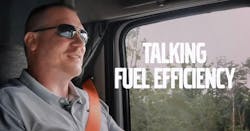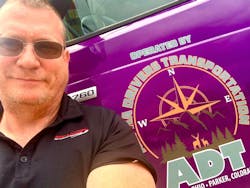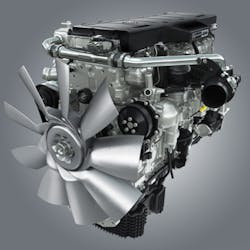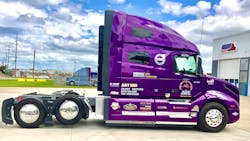Joel Morrow has dedicated his truck driving career to ensuring drivers squeeze the most out of every drop of diesel, but in the beginning, when he first started hauling landfill waste with a Chevy pickup in Ohio, he was a "quintessential outlaw."
"It was multiple logbooks. I'd done what everybody else done," Morrow told FleetOwner. "You run everything as fast as you can possibly go and run as many miles as you can."
In his mid-twenties, Morrow realized that hauling so haphazardly was thinning his profit margin and wearing on his health. After a speeding ticket put his CDL in jeopardy, Morrow knew he needed to shift gears.
Five million miles later, Morrow, a self-described trucking "geek," has become one of the trucking community's foremost efficiency experts, starting his consulting service and even being enlisted by Volvo to test the company's new trucks.
"While it was true I didn't get home as quick on specific days, I quickly learned I did not have to work as many days in the year to make the same or more money," Morrow said. "It's crazy that people elect to work harder for less money."
The many benefits of a fuel efficiency mindset
Morrow plans his trips meticulously. Every time before hitting the road, Morrow sits down, figures out his route and how long it is, and figures the lowest cruising speed that he can run to reach the receiver on time. On load boards, Morrow sometimes opts for lighter hauls over simply picking the load with the highest rate per mile, as the fuel savings, plus less wear and tear on his truck, can net him more profit. Morrow also uses an app, inRoute, to check elevation along his journeys.
See also: Lessons learned on efficiency: Tales from the road
"If everybody on the road slowed down, initially you would see a tightening of capacity," Morrow said. "But over time, it's probably going to become more efficient because you're stopping to fuel less. It's less stress and strain on the driver. It's less maintenance. You're going to have fewer road calls, fewer problems out on the road. So the idea that you can drive as fast as you want without there being penalties for that decision is just ludicrous."
What to look for in a downsped engine
Morrow runs Alpha Drivers Testing and Consulting as well as Alpha Drivers Transportation, in which he tests products for companies such as Volvo, Dana Corporation, and Phillips Industries, giving feedback directly to their engineers.
Morrow, when examining engine architecture to determine whether the engine is genuinely downsped or "just a regular old engine that they've applied the term to," searches for some key features.
Morrow acknowledged naysayers that call the design inefficient, but he countered that it's only inefficient at traditional gear ratios and lends itself well to downspeeding.
"The engine architecture plays a huge role," he said. "Is it actually a downsped engine, not just some software applied to a traditional design? And that engine friction reduction plays a role not only in improving fuel efficiency just because we reduce mechanical drag, but when we reduce mechanical drag, that means our aerodynamics work better and our rolling resistance works better," he said. "So you get huge results."
Burning less fuel means burning less cash on truck maintenance
"I'm thinking that the maintenance aspect of this may be even more important than the fuel efficiency gains," Morrow told FleetOwner.
As a downsped engine rotates fewer times over the same number of miles compared to its counterparts, more heat is retained in the combustion process because less air is moving through the engine. And when engine temperature rises, there are fewer particulates produced to wear on the emission system, which Morrow said "virtually eliminated any form of emission system issues" that he used to commonly see.
Morrow said that strict maintenance is essential for his efficiency gains, saying, "I like to get a little aggressive with the factory recommendations." He runs the overhead on his engine every year regardless of miles, adjusting valves to ensure proper combustion.
"I find that to be a huge factor in maintaining optimal fuel efficiency. These newer engines, believe it or not, are very sensitive to valve adjustment," he said.
See also: The connection between maintenance and fuel efficiency
Every year, when running the overhead, Morrow also retorques injectors, cleans off the crank position sensor, and changes the boost sensor, all for less than $1,000—much less than the $15,000 or more that an emission system breakdown can cost on the road.
"If I spend $3,500 bucks a year on maintenance," Morrow said, "that's a high number."
Optimizing truck aerodynamics for fuel efficiency
Morrow uses a number of aerodynamic devices—full fairings on the back of the cab, chassis fairings—but according to him, none of those devices are properly utilized if chassis specs aren't optimized.
"Right now I have a 14-6 front axle and we're going to do a retrofit to upgrade that to 16,000 lb.," Morrow said. "This allows me to run a very far set forward fifth wheel position. So I have 39 inches between the back of the cab to the front of the trailer and about 15 inches from my side fairing to the radius of the trailer, so I have a very tight gap, which makes me very aerodynamically efficient. You cannot run that tight gap unless you have the correct steer axle and tire capacities up front. So often I see a guy with a very aerodynamic truck with a 12,000-lb. front axle, which is very common in the industry, and he has to run a 65-inch back of cab, in front of trailer gap because he can't get legal on his front. And so what good's aerodynamics if you can't actually close the gap up and leverage the benefit?"
See also: No more skirting the trailer skirt issue
Aerodynamics is paramount in winter because the cold, dense air provides more resistance, according to Morrow.
"How often do we see fleets say, 'Oh, I lose a mile-and-a-half, two miles a gallon in the winter. It's the winter diesel fuel.' No. It's the dense cold air you're trying to push through." A well-managed fleet will still lose at least half a gallon per mile on average, Morrow said.
"When times get hard, that efficiency is going to open up opportunities, it's going to keep you in business, and it's going to allow you to run freight that the inefficient guy cannot run."
About the Author
Scott Keith
Scott Keith is a former fleet owner digital editor, who was on staff from 2022 to 2023.





